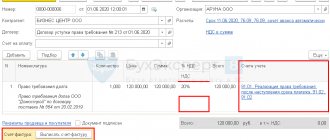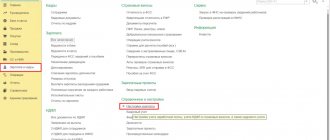Turnover on account 60 and its application in accounting
Account 62 “Settlements with buyers and customers” is intended to summarize information on settlements with buyers and customers.
Account 62 “Settlements with buyers and customers” is debited in correspondence with accounts 90 “Sales”, 91 “Other income and expenses” for the amounts for which settlement documents were presented.
Account 62 “Settlements with buyers and customers” is credited in correspondence with the accounts for recording cash, settlements for the amounts of payments received (including the amounts of advances received), etc. In this case, the amounts of advances received and prepayments are taken into account separately.
If interest is provided on the received bill of exchange securing the debt of the buyer (customer), then as this debt is repaid, an entry is made to the debit of account 51 “Currency accounts” or 52 “Currency accounts” and the credit of account 62 “Settlements with buyers and customers” (on amount of debt repayment) and 91 “Other income and expenses” (by the amount of interest).
Analytical accounting for account 62 “Settlements with buyers and customers” is carried out for each invoice presented to buyers (customers), and for settlements with scheduled payments - for each buyer and customer. At the same time, the construction of analytical accounting should provide the ability to obtain the necessary data on: buyers and customers on payment documents for which the payment period has not yet arrived; buyers and customers on payment documents not paid on time; advances received; bills for which the due date for receipt of funds has not yet arrived; bills discounted (discounted) in banks; bills for which funds were not received on time.
Accounting for settlements with buyers and customers within a group of interrelated organizations, the activities of which are compiled consolidated financial statements, is kept on account 62 “Settlements with buyers and customers” separately.
Account 62 “Settlements with buyers and customers” corresponds with the accounts:
| By debit | By loan |
| 46 Completed stages of work in progress 50 Cash 51 Current accounts 52 Currency accounts 55 Special bank accounts 57 Transfers in transit 62 Settlements with buyers and customers 76 Settlements with various debtors and creditors 79 On-farm settlements 90 Sales 91 Other income and expenses | 50 Cash 51 Current accounts 52 Currency accounts 55 Special accounts in banks 57 Transfers in transit 60 Settlements with suppliers and contractors 62 Settlements with buyers and customers 63 Provisions for doubtful debts 66 Settlements for short-term loans and borrowings 67 Settlements for long-term loans and borrowings 73 Settlements with personnel for other transactions 75 Settlements with founders 76 Settlements with various debtors and creditors 79 On-company settlements |
How to keep records on account 60 in 1C: Accounting?
Send this article to my email
The material below will be devoted to the issue related to accounting on account 60 in 1C: Accounting 3. Account 60 represents the organization’s settlements with its suppliers and contractors, which in turn has several subaccounts subordinate to it. Account 60 in 1C is used to aggregate data on settlements with counterparties for goods, materials and other valuables, work performed or services rendered.
Those organizations that are engaged in performing work under contracts related to construction work, design and technological work or under a general contract agreement, settlements with subcontractors are also reflected in this account. The account is credited for the amount of accepted goods, services or works that were accepted for accounting. In turn, it is debited for the amounts for the fulfillment of obligations. This also includes advances and prepayments.
I will set up your 1C. Experience since 2004. Read more →
Analytical accounting for this account should be kept separately, namely in the context of each submitted invoice. In order to view the decryption of the account, you need to go to the “Main” section and select the “Chart of Accounts” item. In the search window, for convenience, you can set the value to “60” and the program will automatically select a list of accounts containing this code. The typical functionality of the program contains the following subaccounts:
Let's look at each of the subaccounts in more detail:
60.01 – used to account for mutual settlements with creditors
60.02 – used to reflect advance payments to suppliers
60.03 – intended to reflect transactions on securities
The last two subaccounts 60.21 and 60.22 are analogues of 60.01 and 60.02, respectively, intended for calculation in foreign currency. And accounts 60.31 and 60.32 are intended for accounting in conventional units. The account is active-passive, as it can contain both receivables and payables.
By clicking on the hyperlink “Accounts for settlements with counterparties” in the header of the account plan list form, the corresponding form will open. Here you can set settlement accounts by organizations, counterparties and contracts.
For example, upon receipt, settlement accounts are specified in the header using the corresponding hyperlink. After which a window will open with the calculation settings.
In order to analyze how accounting is maintained for account 60, you can use the “Account balance sheet” report. This report is located in the “Reports” section of the program. In the header of the report we indicate the required organization, period and account 60.
Please note that subaccounts are also displayed. Let’s go to the list settings by clicking the “Show settings” button. In the settings, the “By subaccounts” checkbox is checked. We will also additionally display a grouping by contracts and settlement documents.
On the “Selection” tab, you can set selection by available fields. Let's reformat the report for the new groupings, after which it will take the following form.
The “Account Analysis” report in the “Reports” section can also be useful, which allows you to display information between the selected account, in our case 60, and all other accounts for the specified period.
Watch video instructions on channel 1C PROGRAMMER EXPERT
EVERYONE MUST DO THEIR JOB! TRUST THE 1C SETUP TO A PROFESSIONAL. MORE →
Discuss the article on the 1C forum?
Score 60, 62
At the end of the reporting period, a VAT return is drawn up, the accumulated VAT for deduction of the Supplier (according to Dt account 19) is written off to reduce the debt for accrued VAT on sales (according to Kt 68 VAT subaccount) In this case, the following entry is made: Dt 68 (VAT subaccount) Kt 19, and the final debt due for payment of VAT to the budget is displayed. The debt payable will be listed under Kt 68 (VAT sub-account) . It should be noted that Kt-e balance in account 68 (VAT sub-account) . A situation may arise when the amount of Supplier's VAT collected under Dt account 19 for the reporting period exceeds the amount accrued under Kt-u account 68 (VAT sub-account) , then when posting Dt 68 (VAT sub-account) Kt 19 , under account 68 (sub-account VAT) a Dt-e balance arises and the enterprise submits a VAT return with the result of a VAT refund from the budget, and not for payment as usual.
Standard entries for accounts receivable and accounts payable:
Account 60 “Settlements with suppliers and contractors” corresponds with the accounts:
debit 60 with credit accounts - 50 Cash, 51 Current accounts, 52 Currency accounts, 55 Special accounts in banks, 60 Settlements with suppliers and contractors, 62 Settlements with buyers and customers, 66 Settlements for short-term loans and borrowings, 67 Settlements for long-term loans and borrowings, 76 Settlements with various debtors and creditors, 79 On-farm settlements, 91 Other income and expenses, 99 Profits and losses
on credit 60 with debit of accounts - 07 Equipment for installation, 08 Investments in non-current assets, 10 Materials, 11 Animals for growing and fattening, 15 Procurement and acquisition of material assets, 19 Value added tax on acquired assets, 20 Main production, 23 Auxiliary production, 25 General production expenses, 26 General business expenses, 28 Defects in production, 29 Service production and households, 41 Goods, 44 Selling expenses, 50 Cash, 51 Current accounts, 52 Currency accounts, 55 Special accounts in banks, 60 Settlements with suppliers and contractors, 76 Settlements with various debtors and creditors, 79 On-farm settlements, 91 Other income and expenses, 94 Shortages and losses from damage to valuables, 97 Deferred expenses.
Account 76 “Settlements with various creditors and debtors” corresponds in the same way as account 60. At many enterprises, it is used for accounting with other suppliers of works, services and inventory items, that is, settlements with suppliers for non-core activities or for general business expenses are taken into account. For example, in a construction organization, this account may account for utility bills for the office, office rent, etc. However, the account has a number of sub-accounts for specific transactions. For example, subaccount 76 for accounting for VAT on advances. This subaccount accumulates VAT payable accrued by your company from the amounts of advances received for the reporting period for certain works and services, posting Dt 76 (subaccount for accounting for VAT on advances) Kt 68, subaccount for VAT. Upon completion of work 100% on objects or types of work for which advances were received, the amount of VAT accrued on advances is written off from account 76, posting Dt 68 (sub-account for VAT) Kt 76 (sub-account for accounting for VAT from advances) is made. Account 76 takes into account settlements with budgets for the rental of space in buildings owned by local municipalities and a number of other operations. Due to the brevity of the course, these operations are not covered.
Account 62 “Settlements with buyers and customers” corresponds with the accounts:
by debit 62 with credit accounts - 46 Completed stages of work in progress, 50 Cash, 51 Current accounts, 52 Currency accounts, 55 Special accounts in banks, 57 Transfers in transit, 62 Settlements with buyers and customers, 76 Settlements with various debtors and creditors , 79 On-farm accounts, 90 Sales, 91 Other income and expenses.
on loan 62 with debit accounts - 50 Cash, 51 Current accounts, 52 Currency accounts, 55 Special accounts in banks, 57 Transfers in transit, 60 Settlements with suppliers and contractors, 62 Settlements with buyers and customers, 63 Provisions for doubtful debts, 66 Settlements for short-term loans and borrowings, 67 Settlements for long-term loans and borrowings, 73 Settlements with personnel for other operations, 75 Settlements with founders, 76 Settlements with various debtors and creditors, 79 On-farm settlements.
Characteristics of account 62 and the procedure for calculating the balance
Account 62 “Settlements with buyers and customers” is an actively passive account; in practice, it is mainly active. i.e. debit balance. Account 62 is used for settlements with customers, i.e. persons who buy products or goods from us. The debit of the account reflects accounts receivable, i.e. we owe accounts payable on the loan.
In balance sheet 62, the account is reflected in detail, that is, we look at the amount how much we owe to customers according to analytics (in the context of an individual buyer) and the amount how much customers owe us, that is, if we manually look at the balance according to the reconciliation report, how much is owed to us, how much we owe. amount of balances.
Basic wiring:
- Debit 62 credit 90-Sold goods or products to customers. We see that debit account 62 means that a receivable has arisen (we are owed) if there was no advance payment previously. on the loan account 90, this loan account reflects the revenue amount including VAT.
- Debit 51 credit 62-Received from buyers to pay for goods or products. We see that the loan is 62, this indicates that the receivables have been repaid, that is, the debt to us has been reduced, (if it is not an advance) at the same time the money in account 51 is increasing.
- Debit 60 credit 62-Offset has been made. (If the buyer is also a supplier)
Calculation of the balance or in accounting language the balance of the account.:
Consider the following situations regarding the account balance calculation formulas:
- The balance at the beginning of the loan, the balance at the end is a credit for the synthetic account.
Picture 1.
the amount of 45,000 shows our debt to buyers, this happens when the buyer transfers an advance debit 51 credit 62 to us.
The procedure for calculating the balance: Opening balance + credit turnover - debit turnover = 10000 + 35000 = 45000
- Balance at the beginning debit balance, balance at the end by debit.
Figure 2.
The amount of 70,000 is reflected in the debit of the account, this indicates that the buyers owe us. Calculation procedure Beginning balance + debit turnover - credit turnover.
I forgot to show the transactions on the loan.
- Loan balance at the beginning, debit balance at the end.
Figure 3
We first look at the balance at the beginning of 10,000, then we look at the debit turnover, it is more than the loan turnover, which means that we first sum up the debit turnover, then we subtract the loan turnover. (If the loan turnover were greater, then we would first add the loan turnover and subtract the debit turnover Balance at the end = Balance (balance at the beginning) + debit turnover = 10,000 + 60,000-40,000 = 40,000 rubles.
- The balance at the beginning is a debit balance, the balance at the end is a credit balance.
Figure 4
The amount of 46,000 is accounts payable, that is, we owe it to buyers.
To calculate the final balance, we take the balance at the beginning, look at the debit turnover, it is less than the credit turnover, which means you need to add the credit turnover to the balance and subtract the debit turnover (otherwise, if the debit turnover is greater than the credit, then you would add the debit turnover and subtract the turnover on the loan.) so Balance at the end (formula) = Balance at the beginning + credit turnover - debit turnover = 10000 + 61000-25000 = 46000.
- Formula for calculating the balance of the account 62 customers.
I will repeat the expanded balance (balance) of this account balance, which reflects how much we owe and how much we are owed at the same time on a certain date (indicates that some group owes us a certain amount and we owe it) In the balance sheet, account 62 is reflected in expanded form.
So let's look at the example of calculating the expanded balance. We take the account diagram, Figure 1, where we owe customers (advances received) and take Figure 2, the account scheme and combine it into one diagram and get:
Figure 5
Expanded account balance 62.
From the figure we see that we owe buyer 1 10,000 at the beginning of the period; he sent an advance debit 51 credit 62 25,000+10,000 rubles. total turnover is 35,000. The formula for calculating the balance at the end is 10,000+35,000=45,000. We owe the buyer 45,000. Buyer 2 owes us 10,000 rubles at the beginning for the period he bought goods from us in the amount of 60,000 (25,000 + 35,000) debit 62 credit 90. The formula for calculating the balance at the end is 10,000 + 60,000 = 70,000.70,000 buyer 2 owes us. This scheme is called a synthetic account, i.e. There are 2 or more buyers here. The amount of 70,000 accounts receivable is reflected as a debit and will be in the balance sheet as an asset in the accounts receivable line. The amount of 45,000 will be in the liability side of the accounts payable line, i.e. we owe. This scheme is called an expanded balance, i.e. we both owe it to customers and owe it to us.
Other examples of final balance calculations
Friends, there are still nuances of aircraft according to the analysis of accounts 62/01 62/02 such a “mess” with the calculation of final balances, it is difficult to explain.
Description of the account “Settlements with suppliers and contractors (in cu)”
Reflects all payments to its suppliers or contractors in Russian rubles, and not in the currency as indicated in the expense documents. This need arises if the company has already purchased products or raw materials from another organization, a shipment has occurred, or the first event in the calculations was full payment for the upcoming transaction.
A similar situation may arise when planning various work or maintenance. In this case, payment is made according to the issued invoice or concluded agreement, but not in foreign currency, as indicated in the document, but in Russian rubles.





